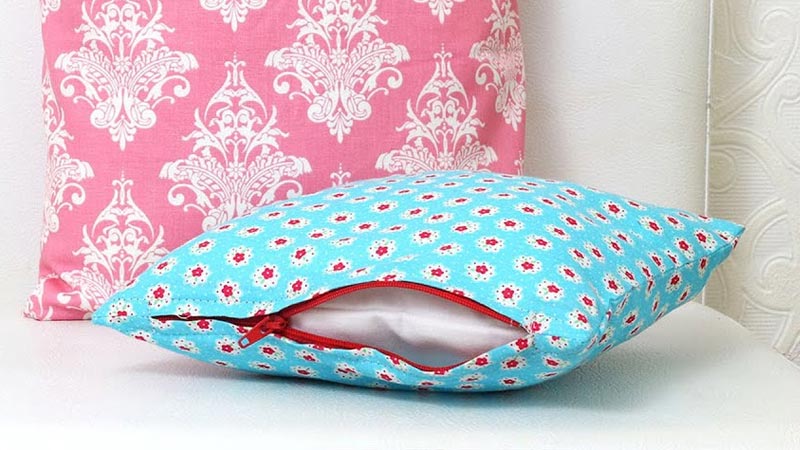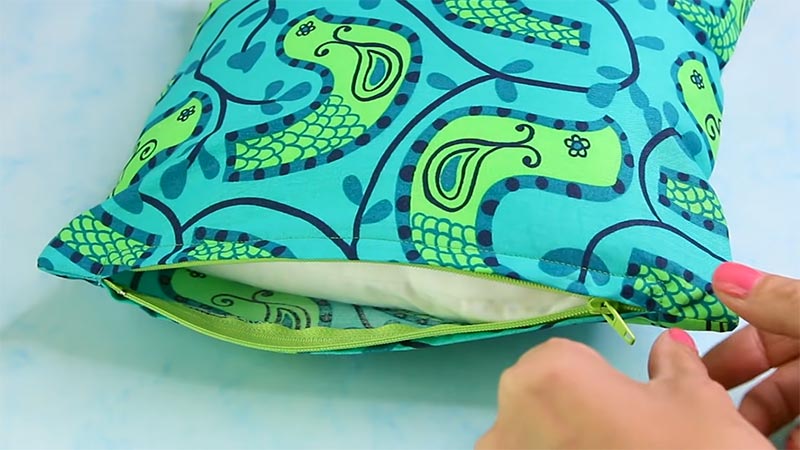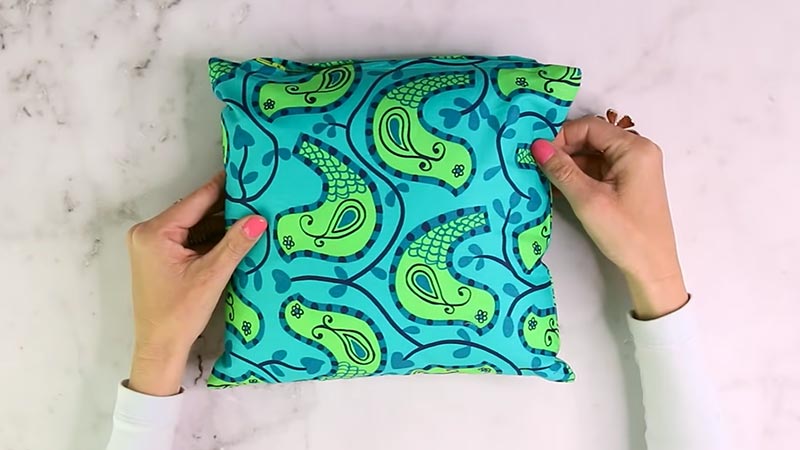The art of crafting zippered cushion covers is a creative endeavor that blends functionality with personal expression.
These covers serve as protective shells for your cushions and as versatile design elements that can breathe new life into your living spaces.
This guide will explore the step-by-step process of creating custom zippered cushion covers that fit your cushions like a glove.
From measuring and cutting fabric to selecting the right zipper and mastering the sewing techniques, you’ll embark on a journey of creativity and craftsmanship.
Get ready to elevate your home decor and showcase your sewing skills with these stylish and practical creations.

How to Make Zippered Cushion Covers?
Making zippered cushion covers is a great way to refresh the look of your living space and add a personal touch to your decor.
Whether you’re a seasoned seamstress or a beginner, this project can be accomplished with some patience and attention to detail.
Here’s a step-by-step guide on how to make zippered cushion covers:
Materials You’ll Need:
- Fabric for the cushion cover
- Matching thread
- Zipper (preferably longer than the cushion’s width)
- Sewing machine (or you can hand-sew if you prefer)
- Scissors
- Measuring tape or ruler
- Straight pins
- Iron and ironing board
Measure and Cut the Fabric
Begin by measuring your cushion meticulously. Consider not only the length and width but also the thickness, as this will determine the overall dimensions of the cover.
Add an extra inch to both the length and width measurements. This additional inch accommodates the seam allowances, ensuring a snug and professional fit for your cushion.
Cut the Fabric
Lay out your chosen fabric on a clean, flat surface. Place the measuring tape or ruler against the fabric and mark the dimensions you’ve measured. Take your time to make sure the lines are straight and accurate.
Using fabric scissors, cut along these lines. This will give you the front and back pieces needed for your cushion cover.
Prepare the Zipper
Lay the zipper face down on the edge of one of the back fabric pieces. Ensure that the zipper pull is facing toward the fabric. Leave a little extra tape extending beyond the edge. This extra tape will be trimmed later.
Use straight pins to secure the zipper in place. It’s a good idea to pin it at both ends and in the middle to prevent any shifting during sewing.
Stitch the Back Panels
Position the front fabric piece face up. Place one of the back pieces face down on top of it, aligning the edges. The zipper should be sandwiched between the two pieces.
With everything aligned, pin the edges together. Then, stitch along the three sides using your sewing machine, maintaining a 1/2-inch seam allowance. Be sure to backstitch at the beginning and end for added durability.
Repeat this process for the other back piece, ensuring that the zipper aligns with the first piece.
Trim and Press
After sewing, trim any excess fabric from the edges, being careful not to cut too close to the stitches. To reduce bulk in the corners, clip them diagonally. This will help the cover maintain its shape when turned right side out.
With the cover turned right side out, use an iron to press the seams. This will give them a crisp, professional finish.
Insert the Cushion
As you open the zipper halfway, take a moment to appreciate your progress. This little detail is what will allow you to slide the cushion into its new cover easily. Gently guide the cushion into the cover, paying special attention to the corners.
Press down on the edges to ensure the cushion fills out the cover completely. This attention to detail will result in a cover that looks custom-made for your cushion.
Close the Zipper
With the cushion snugly inside, it’s time to seal the deal. Gradually, but with purpose, zip up the cover. As the zipper pull glides smoothly, you’ll witness the transformation from a fabric sheath to a finished cushion cover.
This final step completes the look and ensures that the cushion remains securely housed within its cover, ready to add comfort and style to your living space.
What Type of Zipper Do You Need for a Cushion Cover?

It’s best to use a regular or standard zipper for a cushion cover. These zippers are the most commonly available and are well-suited for most sewing projects, including cushion covers.
When selecting a zipper, consider the following factors:
Length
When selecting a zipper for your cushion cover, it’s important to choose one that is longer than the width of the opening. This ensures that the zipper can extend beyond the edges of the fabric, making it easy to insert and remove the cushion.
A zipper that is 2 to 4 inches longer than the opening is typically a good choice. This additional length provides some flexibility while still allowing for a secure closure.
Type
Regular or dressmaker zippers are the preferred choice for cushion covers. These zippers have fabric tape on both sides, making them versatile and suitable for various sewing projects.
They are widely available in various lengths and colors, allowing you to find the perfect match for your fabric.
Color
Consider the color of your fabric and your space’s overall design scheme. You can choose a zipper that blends seamlessly with the fabric, creating a subtle and cohesive look.
Alternatively, you can opt for a contrasting color for a decorative touch. This choice can add a pop of visual interest to your cushion cover.
Closed-End vs. Separating
For cushion covers, a closed-end zipper is the appropriate choice. Closed-end zippers have a stopper at one end, preventing them from fully separating when opened.
This design ensures the cushion remains securely enclosed within the cover, preventing accidental slips or spills.
Size
Zippers come in various sizes, typically measured in inches or centimeters. It’s crucial to select a zipper that matches the width of the opening of your cushion cover.
A common size for cushion covers is around 18 inches or 45 centimeters. Ensure that the zipper is long enough to extend beyond the edges of the fabric, allowing for easy access to the cushion.
Quality
Investing in a good-quality zipper is essential. Look for zippers from reputable brands like YKK, known for their durability and smooth operation.
A high-quality zipper will ensure ease of use and contribute to the overall longevity and functionality of your cushion cover.
Zippered Cushion Covers Cleaning and Care

Cleaning and caring for your zippered cushion covers is essential to maintain their appearance and extend their lifespan.
Here are some steps and tips to keep them looking fresh and beautiful:
Regular Maintenance
Regular maintenance is crucial for keeping your zippered cushion covers looking fresh. Vacuum or shake out the cushions periodically to remove any dust or debris that may have accumulated.
Additionally, rotating or flipping the cushions can help ensure even wear and prevent one side from fading more.
Check the Care Label
Always start by checking the care label on your cushion covers. This label provides specific instructions for cleaning and maintenance that should be followed to preserve the integrity of the fabric.
Spot Cleaning
For small stains or spills, it’s best to address them promptly. Use a clean, damp cloth or sponge and a mild soap to blot the affected area gently. It’s important to avoid rubbing, as this can spread the stain and potentially damage the fabric.
Machine Washing
When your cushion covers are machine washable, remove the cushion inserts and unzip the covers. Use a gentle cycle with cold water and a mild detergent.
Consider adding a color-preserving product to the wash to prevent colors from fading. Be cautious not to overload the washing machine to ensure thorough cleaning.
Hand Washing
Hand washing is a suitable alternative for delicate fabrics or covers that aren’t machine washable. Fill a basin or tub with cold water and add a small amount of mild detergent. Gently agitate the water and submerge the cushion cover, swishing it around to clean.
Rinse thoroughly with cold water until all detergent is removed. It’s important to avoid wringing or twisting the fabric, as this can cause damage.
Drying
When it comes to drying, it’s crucial to avoid high heat settings in the dryer unless the care label specifically recommends it. If your cushion covers are dryer-safe, use a low-heat setting or opt for air-drying.
To prevent wrinkles, remove the covers from the dryer promptly and reshape them if necessary.
Ironing
When ironing is necessary, do so in a low-heat setting. Use a pressing cloth or a towel between the iron and the fabric to protect it from direct heat.
Dry Cleaning
For cushion covers labeled as “dry clean only,” it’s advisable to follow these instructions and take them to a professional dry cleaner.
Protect from Sunlight
Prolonged exposure to direct sunlight can cause fading and damage to the fabric. Consider using curtains or blinds to shield your cushions from harsh sunlight.
Stain Repellent Treatment
Applying a stain-repellent treatment to your cushion covers can offer an extra layer of protection against spills and stains. Be sure to follow the manufacturer’s instructions when using these products.
FAQS
What materials do I need to make a zippered cushion cover?
You’ll need fabric, matching thread, a zipper longer than the cushion’s width, a sewing machine or needle and thread, scissors, measuring tape or ruler, straight pins, and an iron with an ironing board.
Can I use a regular zipper for cushion covers?
Yes, you can use a regular zipper for cushion covers. It’s the most common choice, and it should be longer than the cushion’s opening for easy insertion and removal.
What is the purpose of adding seam allowances when making cushion covers?
Seam allowances provide extra fabric along the edges of your cushion cover pieces, allowing room for sewing and preventing a too-tight fit.
Do I need a sewing machine to make zippered cushion covers?
No, you can hand-sew zippered cushion covers if you don’t have a sewing machine. It may require more time and patience, but it’s entirely possible.
What care instructions should I follow for zippered cushion covers?
Care instructions may vary depending on the fabric used. Always check the care label, but generally, you can spot clean small stains, machine wash with care, or dry clean as indicated.
What is the recommended zipper length for cushion covers?
The recommended zipper length should be longer than the width of the cushion’s opening, usually by 2 to 4 inches. This ensures easy insertion and removal of the cushion
To Recap
In crafting zippered cushion covers, attention to detail transforms fabric into functional art. Precise measurements and careful cutting lay the foundation. Seam allowances and a well-chosen zipper ensure a snug fit.
Whether machine-sewn or hand-stitched, each step is a testament to patience and skill. The final product, with its clean lines and hidden closure, brings a touch of sophistication to any space.
Regular maintenance and proper care extend the cover’s lifespan, preserving its beauty. Through this creative process, a simple piece of fabric becomes a personalized touch, enhancing comfort and style in the home.
Making zippered cushion covers is not just a craft; it’s an art form, infusing spaces with warmth and personality.
Leave a Reply